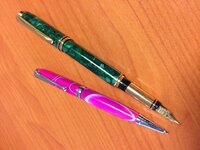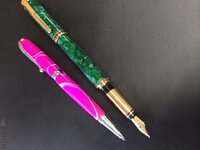Beautiful! Stunning. Is there a technique that you practice that prevents or eliminates doesn't micro scratches left behind by the circular finishing tool. No matter how lightly I make contact, I get very fine scratches. Tried dry sanding, wet sanding, BG products etc. Thank you!
Tony, If you are experiencing circular scratches, it sounds that your sanding practice may need some changes.
Firstly with any material, but particular cast blanks, you will seldom get an off the tool finish that doesn't need sanding.
I suggest that you look at the off tool finish quality, and select your starting grit based on that finish quality, probably say 320 grit, use clean paper and move the paper over the total length of the blank while it is turning.
Don't hold it in one place, when finishing with the lathe turned off lightly move the paper lengthways over the entire blank.
Then wipe with a piece of paper towel soaked with DNA.
Repeat this through every grit till you get a satisfactory finish. probably 1200 or 2400.
I would then use Micro Mesh and repeat the process through all grades.
You can then use a Plastic polish if needed.
Most important use clean paper, and always keep it moving don't hold it stationary in one position.
Brian.


